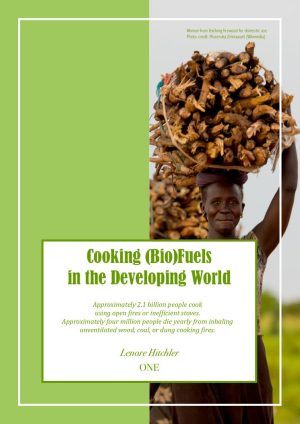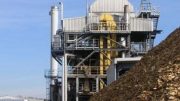 Approximately 2.1 billion people cook using open fires or inefficient stoves. Approximately four million people die yearly from inhaling unventilated wood, coal, or dung cooking fires.
Approximately 2.1 billion people cook using open fires or inefficient stoves. Approximately four million people die yearly from inhaling unventilated wood, coal, or dung cooking fires.
Humans must eat food, and much of what is consumed needs to be cooked.
A large proportion of the population of developing countries, also referred to as the Global South, relies on biomass. Biomass is organic matter and consists mostly of trees, charcoal, bushes, crop residues, and dung. Additionally, a smaller number of people in developing countries use kerosene, liquified petroleum gases, coal, and electricity powered by fossil fuels.
Using fossil fuels involves extraction, processing, and transportation. Both fossil fuels and biomass produce pollution that damages human health and the environment and greenhouse gases that lead to climate change. However, since biofuels are the most prevalent form of energy used for cooking food in the developing world, it is reasonable to examine their effects on their users. The people of the Global South could then take these considerations into account when planning their future.
Unfortunately, the use of cooking fuels in the developing world has not been adequately studied. Additionally, some of the research is several decades old.
However, the older research is still highly relevant as the Global South generally has not changed its reliance on biomass fuels.
Unfortunately, some researchers combine cooking and heating fuel statistics when discussing biomass fuels. This makes it difficult to specifically analyze cooking fuel use.
Another difficulty in reporting on cooking fuels is that specific statistics differ from source to source. However, the various data are consistent in showing the many adverse effects of using cooking fuels.
Cooking fuels that are polluting and inefficient are used by a vast number of people worldwide. The World Health Organization (WHO) reported in October 2024 that globally, approximately 2.1 billion people cook using open fires or inefficient stoves. The World Bank estimates that globally doing so costs more than $2.4 trillion annually.
Women pay much of the price for suboptimal cooking methods. They are responsible for cooking most of the food that is consumed worldwide, and it is unpaid work that takes up much of women’s time. Women gather most of the biomass used for cooking. Gathering biomass for cooking fuels is very strenuous.
The World Health Organization reported that “loads of wood, dung, and other fuels can weigh 40 kilograms [a little over 88 pounds] or more and are carried on their [women’s and girl’s] backs or heads. Common sense suggests that the cumulative physical strain of performing these tasks, day after day, year after year, is considerable. But there are few empirical studies on the injuries and types of chronic discomfort – muscle strains, spinal injuries, headaches, bone fractures, backaches, rheumatism and complications of pregnancy, to name but a few – that women incur in the process of procuring wood and other polluting fuels.”
According to an article in Energy Research and Social Science, this can cause serious long-term physical damage to their backbones and legs. When gathering firewood, women are also vulnerable to rape and other violence.
The exact number of hours spent gathering firewood varies from source to source. An article in Energy for Sustainable Development in 2022 reported that women in Africa spend 3.5 to 8 hours a day collecting firewood for cooking. According to the Institute for War & Peace Reporting, women in rural Tanzania can walk ten kilometres [approximately 6.21 miles] daily to collect enough cooking firewood. The World Health Organization reported that girls spend an average of 18 hours weekly gathering fuel. This can prevent them from attending school and getting an education.
When firewood is not available, women collect a large amount of crop residues and dung. An article in Ecological Economics in 1999 reported that “350 tons of crop residue and 400 million tons of dung are also burned annually. Worldwide, more than 2 billion people use dried dung as a cooking and heating fuel. Had the animal wastes alone been used to fertilize the soil, 14 million additional tons of grains could have been grown.” Using dung for cooking fuel also endangers human health. For example, an article in energypedia reported that burning dung emits far greater quantities of dioxins than does wood, and dioxins are extremely toxic as well as being carcinogenic.
Along with the hazardous health effects of cooking fuels on women, using these fuels also endangers children. An article in Occupational and Environmental Medicine reported on the adverse effects of using various cooking fuels on childbirth. Each fuel source was statistically related to its own specific poor birth outcomes such as preterm birth, stillbirths, lower birth weights, lower body length and head circumferences, lower Apgar scores, and increased infant mortality during the first months of life.
One of the unhealthiest pollutants produced during the cooking process is black carbon. Black carbon, also known as BC, is formed through the incomplete combustion of fossil fuels and biomass. Black carbon particles are a major component of soot. The Climate & Clean Air Coalition is a United Nations Environment Programme initiative.
They reported that black carbon “has a warming impact up to 1,500 times stronger than CO2 per unit of mass. … About 5.8 million tonnes of black carbon were emitted in 2019. … When suspended in the atmosphere, black carbon contributes to warming by converting incoming solar radiation to heat. … Black carbon also influences cloud formation and impacts regional weather and rainfall patterns. [Thus, BC alters tropical rainfall and causes erratic and undependable Asian monsoons therefore decreasing crop yields and putting the food supplies of millions at risk.] … When deposited on ice and snow, black carbon particles reduce surface albedo (the ability to reflect sunlight) and heat the surface. This effect is estimated to have contributed to 0.04 degrees Centigrade of warming since 1750. The Arctic and glaciated regions such as the Himalayas are particularly vulnerable to melting as a result. … In combination with tropospheric ozone, black carbon also contributes to over 50 million tonnes of staple crop losses globally each year.”
According to the World Resources Institute, tropospheric ozone is harmful because it reduces photosynthesis and plant growth. The Institute also reported that black carbon damages human health and contributes to respiratory and heart disease. The World Health Organization reported that in children under five, 45% of pneumonia deaths are caused by inhaling black carbon.
Black carbon is one of the components of household air pollution (HAP). According to the World Health Organization, “Household air pollution is generated by the use of inefficient and polluting fuels and technologies. … These unhealthy cooking fuels can produce smoke that is 100 times the acceptable levels of particulate matter.”
Household air pollution contributes to numerous health problems. The World Health Organization reported that “A number of epidemiological studies offer strong evidence that HAP is associated with cataract formation – which is the main cause of blindness in adults in developing countries. … HAP causes strokes, heart disease, respiratory infections, chronic obstructive pulmonary disease, and lung cancer and leads to an estimated 3.2 million deaths yearly.”
According to an article in Nature, approximately four million people die yearly from inhaling unventilated wood, coal, or dung cooking fires. Household air pollution also eventually moves outside thus contributing to air pollution. According to the Clean Cooking Alliance, HAP contributes 16% to the total global amount of outdoor air pollution.
Other sources reiterate the harmful effects of the air pollution caused by cooking fuels. Kirk Smith, PhD, was a professor of global environmental health. He was an expert on the effect of household energy on health. He stated that “A typical wood-burning stove might produce 400 cigarettes’ worth of smoke every hour.”
Scientists have published even more data on the detrimental effects of cooking fuels. According to Chest, there are many organs affected by the air pollution produced by cooking stoves. Some of these organs are the heart, lungs, liver, eyes, and the brain. Air pollution can also contribute to disorders such as osteoporosis, dementia, obesity, diabetes, leukemia, and other cancers.
The relationship between cancer and cooking fuels has been further researched by various scientists. For example, the International Agency for Research on Cancer is part of the World Health Organization. Their 2020 study found that “there is strong evidence that household burning of biomass and kerosene fuels, especially using stoves without a chimney, increases the risk of developing several cancers of the digestive tract.” An article in Thorax in 2015 found that “exposure to household use of biomass fuel almost doubled the risk of lung cancer for women.”
Men who have been exposed to cooking fuels also have higher rates of lung cancer than other males but not as high as women. It is speculated that their rates are lower because they spend less time in cooking areas.
Further evidence of the harmful effects of cooking fuels was found in an article in Ecological Economics. The article reported that “Smoke from burning fuelwood contains high levels of respirable particulates, carbon monoxide, nitrous oxide, benzene, formaldehyde, benzopyrene and aromatics. Cooking often takes place indoors, leading to concentrations of hazardous fumes that can exceed smoke levels in industrialized cities. … A study in Nepal found a direct correlation between the number of hours a child spent near an indoor fire and the incidence of acute respiratory infections.”
An article in the International Journal of Health Planning and Management added that “Firewood, crop residues, kerosene, and animal dung are considered as dirty fuels because consumption of these fuels adversely affects both human health and the environment due to the emission of pollutants. These pollutants generally include Carbon Dioxide (CO2), Carbon Monoxide (CO), Oxides of Nitrogen, (NOx), Nitrogen Dioxide (NO3), and Volatile Organic Compounds (VOCs), which include toxic substances, such as benzene, formaldehyde. … Firewood burning increases households’ probability of asthma prevalence by 10.9 percentage points.”
Along with the harmful health effects of using biomass as a cooking fuel, the World Health Organization reported that cooking with fossil fuels is also unhealthy. Burning kerosene produces black carbon and high levels of particulate matter.
The coal used in cooking frequently contains arsenic, lead, mercury, and other toxic substances. These toxins become airborne thus contributing to household air pollution.
Using firewood for cooking fuel also contributes to deforestation. According to the United Nations Food and Agriculture Association, approximately 4 billion cubic meters, which equals 1,412,586,669 tons of wood, were harvested in 2022.
According to an article in energies, “demand for firewood for cooking and heating accounts for the burning of 55% of wood harvested globally.” Deforestation endangers the approximately two billion people who directly rely on forests for food staples including meat and fruits.
An article in Science reported that in 2000, 470 million tons of firewood were harvested in sub-Saharan Africa, while India and China harvested 340 million tons. According to the Clean Cooking Alliance, the Democratic Republic of the Congo lost over a million acres of forest in 2020 due to the harvesting of firewood. Deforestation also leads to soil erosion and loss of habitat and biodiversity.
Burning firewood increases greenhouse gases and leads to climate change. According to the World Resources Institute, “When burned, trees generate more CO2 emissions per unit of energy generated than fossil fuels.”
The Clean Cooking Alliance reported that emissions from wood cooking fuels are approximately one Gigaton, which equals 1,000,000,000 tonnes of CO2 annually. The Intergovernmental Panel on Climate Change reported that worldwide, replacing traditional open fires with improved stoves could reduce between 0.6 and 2.4 gigatons of carbon dioxide equivalent yearly.
Charcoal burned in cooking stoves also leads to deforestation. Charcoal is produced when wood is heated in a kiln. Its use is harmful to the environment and human health. An article in Environmental Science and Technology reported that charcoal stoves emitted larger amounts of greenhouse gases than either traditional open fires or improved ceramic woodstoves.
Dieter Seifert, who has a PhD in engineering, reported on the inefficiency and unsustainability of charcoal fuels. He stated that at least six tons of wood are needed to produce one ton of charcoal. The Clean Cooking Alliance estimated that from five to ten tons of wood are needed to produce one ton of charcoal. The Kleinman Center for Energy Policy reported that in 2018, over 53 million tons of charcoal were produced worldwide. Not all charcoal is used in cooking. However, charcoal does provide a vast amount of cooking fuel.
In contrast to charcoal and other biomass fuels used in the Global South, fossil fuels are used for cooking energy in the developed world.
However, regardless of the source, the energy used to cook foods in both the developed world and the Global South damages health and the environment in addition to contributing to climate change. Therefore, it is appropriate and reasonable to suggest that it would be advantageous for all countries to change their cooking methods. Doing so will directly improve their health and their environment.
Fortunately, positive measures to improve cooking methods are available. Solar cooking is an alternative method of cooking that does not rely on fossil fuels or biomass. Using solar cookers is economical, sustainable, healthier, contributes less to climate change, and is much less damaging to the environment.
Lenore Hitchler





